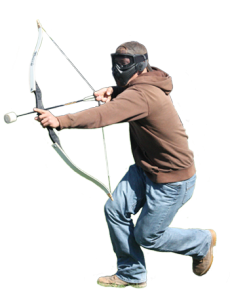
It takes away some of the aggressiveness of the shot, and at the same time, it facilitates the opening of the chest thus allowing a cleaner and more correct shot. It shouldn’t be an option for basic posture, but it can be used as an alternative, a momentary adaptation. The weak point in this posture is that it accentuates the curvature of the back in the lumbar area, and this causes more shooting instability. The strong point is that it increases the alignment of the arm that holds the arch with the shoulder and the back, thus giving more stability to the arm with combat archery .
The vital posture is an aggressive posture. In this case, the back foot is slightly in front of the foot that samples to the line of fire. This stance is widely adopted by composite archers. In this posture the body is more directed towards the target, the concentration ends up being more aggressive, the pull is not so long. this posture is good for relieving back tension, especially when starting to tire during championships. it relieves the lumbar area of the back, straightening the back. The weak point is that this posture weakens the arm that is holding the bow, slightly misaligning it from the ideal position.
As we can see there is no perfect posture. What there are physiological elements that will differ from body to body, each archer has to be analyzed individually and corrected as needed.
The waist and back: Archery Techniques
The second very important element is the waist. As a basis, we can say that the waist should be aligned with the feet and shoulders. The waist is a joint that connects the feet to the rest of the body, and it is through it that we can straighten and balance the body.
The ideal posture is where the waist is aligned with the rest of the body. Untie form if you can save maximum energy and strength when pulling the bow. Each misalignment will strain the muscles more and consequently tire the body faster.
The archer maintains the position of the feet that we have just seen above. In this case, an attempt is made to compensate for the turning of the torso. This waist posture reduces the opening of the arms and chest, forcing the archer to make a smaller opening. It can cause an arrow, even if it is pulled to its normal pull the clicker in the case of recurve, or the hammer in the case of compost to fall during the shot. The reason is that when throwing the arm that holds the bow, it loses tension causing the arrow not to strike with the same momentum. The other problem with this stance is that the arrows tend to go more to the right for right-handed archers and vice versa for left-handers.
Change in posture generates a change in aim

What this does not mean is that, when you are tired, or for an unclear reason, in the middle of the championship all the arrows start to go to the left, after having adjusted the aim, you can compensate for this inexplicable failure, moving your foot a little forward, until the next pause to fix the error in the arch.
What we can never and must forget is that each change in posture generates a change in aim. In case 3, the waist was moved backward to compensate for the position of the feet as in case four. The effect here is the opposite of the effect of case 2. In this case, the arrows tend to go to the left side for right-handed archer, and vice versa for left-handed.
